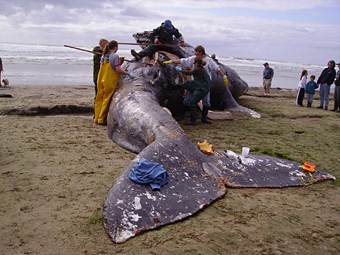
|
 |
 |
 Editorials | Environmental | January 2008 Editorials | Environmental | January 2008  
Argentina: Mystery of the Dead Whales
 Marcela Valente - Tierramérica Marcela Valente - Tierramérica
go to original


| | The scientists studying the matter are looking at different theories as they await the test results of tissue samples taken from the dead whales. | | |
Buenos Aires - It will be difficult to determine exactly why the number of whale deaths has shot up along the Atlantic coast of southern Argentina’s Patagonia region, but experts studying the phenomenon are pointing to poisoning from the "red tide".

The annual average of deaths jumped from 40 to 85 in October and November, according to the Southern Right Whale Health Monitoring Program, conducted over the past five years by non-governmental entities in the southern province of Chubut.

Numbering around 5,300, this colony of southern right whale (Eubalaena australis) is one of hte biggest in the world. They arrive at this stretch of Argentine coast between May and December to reproduce. They are also an attraction for whale-watching tourists.

But the number of whale deaths this year is the highest since 1971.

Most are young whales, measuring up to eight meters long, and have been found around the Valdés Peninsula.

The scientists studying the matter are looking at different theories as they await the test results of tissue samples taken from the dead whales. They don’t expect the tests to fully solve the mystery, but they do expect additional information to continue weaving their hypotheses.

"It will be difficult to come up with conclusive results" due to the advanced state of decomposition of the animals analyzed, biologist Mariano Sirona, science director of the Whale Conservation Institute, one of the organizations involved in the program, told Tierramérica.

The limits on the studies are evidence of the program’s lack of resources, despite the fact that whale-watching draws thousands of tourists to the Chubut coast each year. Only two people show up after a whale is found beached, trapped on the sand. There is a lack of means to act in a timely and appropriate way when such tragedies happen.

For the current whale death crisis, the program has received special funding from the U.S. National Marine Fisheries Service and from the International Fund for Animal Welfare.

According to Sironi, one of the most discussed theories is that the whales are dying from intoxication. It is suspected that toxins from the microalgae that give rise to what is known as red tide are the culprit. The microalgae can be lethal for sea birds and sea mammals that feed on toxic shellfish.

"In October and November there was an intense red tide in Nuevo Gulf," said Sironi, referring to the area where the most dead whales have turned up. But he said it is necessary to wait for the laboratory results before making any definitive statements.

Veterinarian Marcela Uhart, co-director of the monitoring program and member of the Wildlife Conservation Society – another of the participating organizations – is conducting the tissue sample tests and gave a preview of the results: "They are quite meager, as we expected," she told Tierramérica.

The most likely is that the whales were poisoned by an especially lethal type of toxin for mammals, she suggested.

According to Uhart, the last red tide "was incredibly extensive" compared with past years, but she refused to jump to conclusions. She was also cautious in commenting about the possibility that sewage runoff contributed to the whale deaths.

Nuevo Gulf is near the city of Puerto Madryn, and a sewage treatment plant in the El Doradillo district flows into the sea. "We haven’t seen the young whales feeding there. But the it could be that the mothers do, and transmit the poison to their offspring through their milk," Uhart said.

"If we find a digestive tract in a good state (in a dead whale) we would have a better idea," she added.

The notion that the young whales died of malnutrition has been ruled out. "The ones we opened up had a very thick layer of fat, were apparently healthy and well fed," said Sironi.

Also being considered is a combination of causes, such as the red sea in combination with the wounds that seagulls cause on whale backs by feeding on their fat. Those lesions are an open door to infections. "If the toxins depress the animal’s immune system, the whale is more vulnerable to infection," he said.

The problems of coexistence of whales and seagulls have been on the rise in this region. "In 1974 it was one percent of whales injured by birds, and the percentage rose to 38 percent in 1990, and to 68 percent in 2000," said the expert. Although the wounds are not the cause of death, they could be the coup de grace if the animal is already suffering from toxins.

The scientists are not optimistic that the laboratory tests will give the answer because the samples were of such poor quality.

"Most of the whale bodies float for several days, and when they land on the beach they have already begun to decay," said Sironi.

The research teams arrive once the monitoring program alerts them.

Nadia Mohamed, field coordinator of the monitoring, explained to Tierramérica that "due to the topography of the beaches, we can’t access them all with vehicles. Sometimes we have to walk a long way to a whale beaching site."

"We need four-wheelers, and radios or satellite telephones to communicate, because there is no cell phone signal there. And a boat, because there are beaches with steep cliffs that cannot be reached by land," she added.

The scientists also need more staff, wetsuits, necropsy equipment, and money for fuel. Meanwhile, the mystery will remain unsolved. | 
 | |
 |



